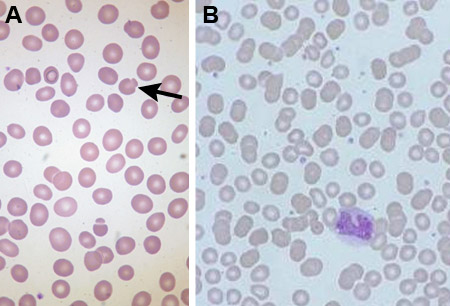Summary
Definition
History and exam
Key diagnostic factors
- presença de fatores de risco
- história familiar positiva
- palidez
- icterícia
- esplenomegalia
Other diagnostic factors
- fadiga
- hidropisia fetal ou feto natimorto
Risk factors
- história familiar de esplenectomia, anemia, icterícia ou esferocitose hereditária (EH)
- características demográficas em risco
Diagnostic tests
1st tests to order
- Hemograma completo
- contagem de reticulócitos
- esfregaço sanguíneo
- bilirrubina sérica
- aminotransferases séricas
- teste de antiglobulina direto (TAD)
Tests to consider
- teste de ligação eosina-5-maleimida
- teste de lise pelo glicerol acidificado
- teste de crio-hemólise
- análise genética
- eletroforese em gel de poliacrilamida contendo dodecil sulfato de sódio
Treatment algorithm
neonatos (<28 dias de idade)
bebês (>28 dias de idade), crianças e adultos: esferocitose hereditária (EH) grave
bebês (>28 dias de idade), crianças e adultos: esferocitose hereditária (EH) leve a moderada
Contributors
Authors
Shelley Crary, MD, MSCS
Associate Professor of Pediatrics
University of Arkansas for Medical Sciences
Little Rock
AR
Disclosures
SC is reimbursed for membership on a drug and safety monitoring board (Novartis) for a non-related drug.
Acknowledgements
Dr Shelley Crary would like to gratefully acknowledge Dr Paula Bolton-Maggs, a previous contributor to this topic.
Disclosures
PB-M has received travel and accommodation payments to give a series of lectures on paediatric haematology, one of which was on HS. She also was an expert witness in a legal case concerning a child with HS. PB-M is an author of some references cited in this topic.
Revisores
Robert Schilling, MD
Professor of Medicine Emeritus
School of Medicine and Public Health
University of Wisconsin-Madison
Madison
WI
Declarações
RS is an author of a number of references cited in this topic.
Créditos aos pareceristas
Os tópicos do BMJ Best Practice são constantemente atualizados, seguindo os desenvolvimentos das evidências e das diretrizes. Os pareceristas aqui listados revisaram o conteúdo pelo menos uma vez durante a história do tópico.
Declarações
As afiliações e declarações dos pareceristas referem--se ao momento da revisão.
Referências
Principais artigos
Eber SW, Armbrust R, Schroter W. Variable clinical severity of hereditary spherocytosis: relation to erythrocytic spectrin concentration, osmotic fragility, and autohemolysis. J Pediatr. 1990 Sep;117(3):409-16. Resumo
Bolton-Maggs PH, Langer JC, Iolascon A, et al; General Haematology Task Force of the British Committee for Standards in Haematology. Guidelines for the diagnosis and management of hereditary spherocytosis - 2011 update. Br J Haematol. 2012 Jan;156(1):37-49.Texto completo Resumo
Perrotta S, Gallagher PG, Mohandas N. Hereditary spherocytosis. Lancet. 2008 Oct 18;372(9647):1411-26. Resumo
King MJ, Garçon L, Hoyer JD, et al. ICSH guidelines for the laboratory diagnosis of nonimmune hereditary red cell membrane disorders. Int J Lab Hematol. 2015 Jun;37(3):304-25.Texto completo Resumo
Iolascon A, Andolfo I, Barcellini W, et al. Recommendations regarding splenectomy in hereditary hemolytic anemias. Haematologica. 2017 Aug;102(8):1304-13.Texto completo Resumo
Davies JM, Lewis MP, Wimperis J, et al. Review of guidelines for the prevention and treatment of infection in patients with an absent or dysfunctional spleen: prepared on behalf of the British Committee for Standards in Haematology by a working party of the Haemato-Oncology task force. Br J Haematol. 2011 Nov;155(3):308-17.Texto completo Resumo
Artigos de referência
Uma lista completa das fontes referenciadas neste tópico está disponível para os usuários com acesso total ao BMJ Best Practice.

Diagnósticos diferenciais
- Anemia não hemolítica
- Outras causas de anemias hemolíticas
- Outras causas de esferocitose
Mais Diagnósticos diferenciaisDiretrizes
- Recommendations regarding splenectomy in hereditary hemolytic anemias
- ICSH guidelines for the laboratory diagnosis of nonimmune hereditary red cell membrane disorders
Mais DiretrizesFolhetos informativos para os pacientes
Cálculos biliares
Icterícia em recém-nascidos: quais são as opções de tratamento?
Mais Folhetos informativos para os pacientesConectar-se ou assinar para acessar todo o BMJ Best Practice
O uso deste conteúdo está sujeito ao nosso aviso legal
